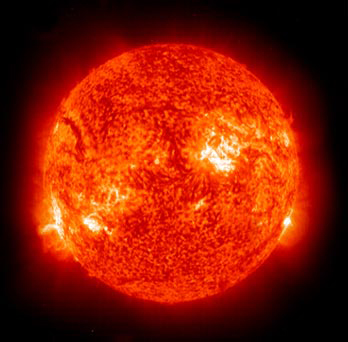The Sun is rather ordinary when it comes to stars. In fact, there are 100 billion stars in our galaxy that are similar to the Sun. What makes our star unique is that it is oursóresponsible for light, heat, and life as we know it.
In our solar system the Sun is by far the largest object. More than 99.8% of
the total mass of our solar system is contained within the Sun. Below are some
other facts about the Sun, compared with Earth where appropriate.
Bulk Parameters
| |
Sun |
Earth |
Ratio
(Sun/Earth) |
| Mass (1024 kg) |
1,989,100 |
5.9736 |
332,950 / 1 |
Gravitational Pull
GM (x 106 km3/s2) |
132,712 |
0.3986 |
332,950 / 1 |
| Volume (1012 km3) |
1,412,000 |
1.083
|
1,304,000 / 1 |
| Volumetric mean radius (km) |
696,000 |
6371 |
109.2 / 1 |
| Mean density (kg/m3) |
1408 |
5515 |
0.255 / 1 |
| Surface gravity (eq.)(m/s2) |
274.0 9 |
78
|
28.0 / 1 |
| Escape velocity (km/s)
|
617.7 |
11.2 |
55.2 / 1 |
| Ellipticity |
0.00005 |
0.0034 |
0.015 / 1 |
| Visual magnitude V(1,0)
|
-26.74 |
-3.86 |
|
Absolute magnitude
|
+4.83 |
|
|
| Luminosity (1024 J/s)
|
384.6 |
|
|
Mass conversion rate (106 kg/s) 4300
|
4300 |
|
|
Surface emission (106J/m2s)
|
63.29 |
|
|
Spectral type
|
G2 V |
|
|
| Model values at center of Sun: |
Central pressure:
|
2.477 x 1011 bar |
Central temperature:
|
1.571 x 107 Kelvin |
Central density:
|
1.622 x 105 kg/m3 |
Credit: Adapted from NASA's National Space Science Data Center Sun Fact Sheet
Solar Energy
It's difficult to comprehend the Sun's energy output because it's so enormousó386
billion megawatts, produced by ongoing nuclear reactions. To put this into perspective,
just one of those megawatts is enough to power 1,000 American homes, an entire
small town.

| This solar image was taken by the Extreme Ultraviolet Imaging Telescope aboard the Solar and Heliospheric Observatory (SOHO) spacecraft. |
|
|
| |
The energy that the Sun emits is created deep within its core. Here intense pressure (340 billion times Earth's air pressure at sea level) and heat (15 million degrees Celsius; 27 million degrees Fahrenheit) cause nuclear reactions to take place.
 |
Find more Facts
about the Sun on the NASA National Space Science Data
Center Web site. (Requires
an Internet connection) |
 |
Learn more about The
Sun on
the Nine Planets Web site.
(Requires
an Internet connection) |
 |
See current solar images at
the Solar
Max 2000 Web site.
(Requires
an Internet connection) |
Page 1 of 1 |
|
|




